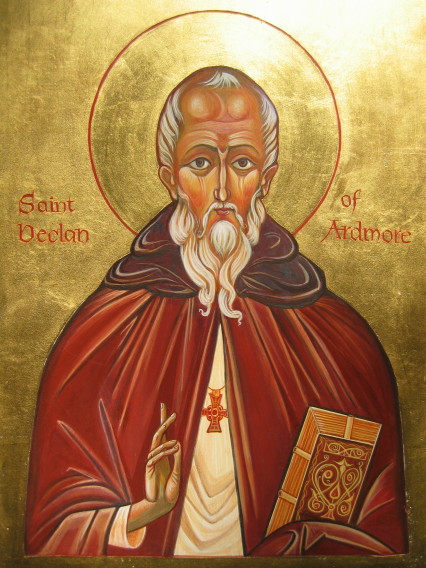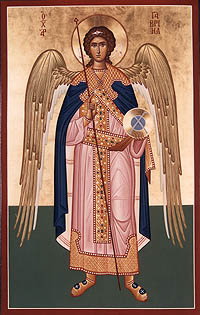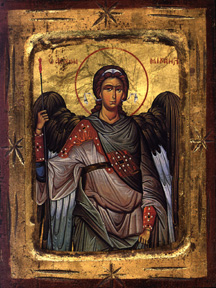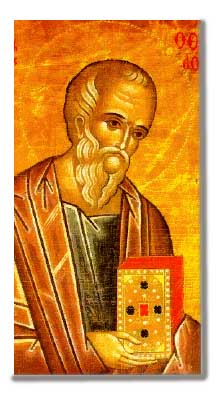Our Patron Saints:
 |
St Declan of Ardmore:
Feast day observed o.c. Aug 6 (n.c. Jul 24)
Troparion (tone 4)
Thou wast a bright light in Ireland before the days of Saint Patrick,/
O holy Father Declan./
Thou didst travel in Europe and return to found a monastery/
where thou wast ever kind to the poor./
We praise thee, O glorious Hierarch.
|
|
|
|
|
|
|
St. Declan, son of Erc, chief of the Desii, was born at the beginning of the fifth century near Lismore, Co. Waterford. As a young boy he was sent to fosterage with a certain Dimma, who is said to have been a foreigner and a Christian. While under Dimma's guardianship, Declan was converted and baptised by one of the several Irish saints named Colman.
After leaving Dimma, Declan went to Rome, where he studied for the priesthood and was later consecrated bishop. On his return to Ireland, he established a monastic community at Ardmore and was later confirmed in this office by St. Patrick himself. Surpising as it may seem, Declan was well known as an active missionary in Ireland prior to the coming of St. Patrick, the great organiser of Irish Christianity.
Many miracles are attributed to the intervention of St. Declan. He is credited, in particular, with having arrested a serious plague by his prayers and fasting. He is reputed to have been a very close friend of St. David (patron saint of Wales) and, perhaps more importantly, to have been on very good terms with Aengus, king of Munster. His influence, therefore, would habe been considerable.
According to legend, Declan made a miraculous return from Rome by crossing the sea on a large flagstone. Popular belief has it that this flagstone ran aground at Ardmore, where he decided to establish his monastery. To this day the flagstone is pointed out by the locals on the popular beach at Ardmore.
St. Declan's day is still actively celebrated by the Ardmore parishioners on 24 July/6 Aug. Until recent times it was the custom, on this day, for those suffering from back ailments to crawl under the flagstone as a method of obtaining relief. One nineteenth century commentator, however, voiced a certain amount of disapproval of the practice on the grounds that participating ladies would, of necessity, reveal their ankles in the process. Such a display could, conceivably, lead the onlooking menfolk into temptation!
The described treatment for backache, however, was said to have been ineffective if the patient had anything borrowed or stolen on his/her person at the time. The waters of St. Declan's well (which was restored in 1951) are said to possess miraculous powers of healing. Those who suffer from sprains, injuries or rheumatism, it is said, will obtain relief by bathing the injured limb in its cool waters.
St. Declan died in the latter half of the fifth century. He was laid to rest in his beloved Ardmore, and his burial place is marked by the ruins of an oratory built over his grave.
If you're interested in reading the entire life of St. Declan of Ardmore... read here...
<<Return to top
 |
Archangel Gabriel:
Feast day observed o.c. Apr 8 & Jul 26 (n.c. Mar 26 & Jul 13)
Troparion (Tone 4)
Supreme Leader of the Heavenly Host,
we implore thee that by thy prayers thou wilt encircle us,
unworthy as we are, with the protection of the wings of thy immaterial glory,
and guard us who fall down before thee and fervently cry:
Deliver us from dangers,
for thou art the commander of the Powers above.
|
|
|
|
|
|
|
The Archangel Gabriel was chosen by the Lord to announce to the Virgin Mary, and through her to all mankind, the great joy of the Incarnation of the Son of God. Therefore, on the day following the Annunciation, on which the Most-pure Virgin is glorified, we thank the Lord and honor His messenger, the Archangel Gabriel, who performed service in the mystery of our salvation.
The Holy Archangel Gabriel is a servant of the Divine Almighty. During the time of the Old Testament, he announced to mankind the coming Incarnation of the Son of God. He inspired the Prophet Moses in his writing the Book of Genesis. He announced to the Prophet Daniel the coming fate of the Hebrew people (Daniel 8:16, 9:21-24). He appeared to the Holy Righteous Anna with the news that the Most-blessed Virgin Mary would be born of her. The Holy Archangel Gabriel was in constant attendance upon the young Holy Mary in the Temple of Jerusalem, and thereafter protected her throughout her life on earth. He appeared to the priest Zechariah, and foretold of the birth of the St. John the Baptist, Forerunner of the Lord. The Lord sent him to St. Joseph the Betrothed: He appeared to Joseph in a dream, and revealed to him the mystery of the Incarnation of the Son of God by the Most-holy Virgin Mary, warned him of Herod’s intentions, and directed him to flee to Egypt with the Divine Infant and the Theotokos. According to Church Tradition, when, before His Passion, the Lord prayed to the point of sweating blood in the Garden of Gethsemane, the Archangel Gabriel was sent to Him from the Heavens. The name Gabriel means “Strength of God” (Luke 22:43).
From the Archangel Gabriel, the Myrrh-bearing Women heard the joyous news of Christ’s Resurrection.
On this day, in remembrance of the Holy Archangel Gabriel’s many apparitions and of his zeal in carrying out the will of God, the Orthodox Church confesses his intercession for Christians before the Lord, and calls its children to run with faith and dedication in prayer to the great Archangel.
<<Return to top
 |
St Michael the Archangel:
Feast day observedbserved o.c. Nov 21 (n.c. Nov 8)
Troparion (Tone 1)
Supreme Leaders of the Heavenly Hosts,/
we implore you that by your prayers you will encircle us, unworthy as we are,/
with the protection of the wings of your immaterial glory,/
and guard us who fall down before you and fervently cry:/
Deliver us from dangers, for you are the commanders of the Powers above.
Troparion (Tone 1)
Let us praise Cherubim, Seraphim, Thrones, Powers, Authorities and Principalities,/
Dominions, Archangels and Angels for they are the Bodiless ministers of the Unoriginate Trinity/
and revealers of incomprehensible mysteries./
Glory to Him Who has given you being; glory to Him Who has given you light;/
glory to Him Who is praised by you in thrice-holy hymns.
Kontakion (Tone 2)
Supreme Leaders of God's armies and ministers of the divine glory,/
princes of the bodiless Angels and guides of men,/
ask what is good for us and great mercy,/
as Supreme Leaders of the Bodiless Hosts
|
|
|
|
 |
|
|
|
|
|
|
The Synaxis of the Leader of the Heavenly Hosts Michael, and the Other Heavenly Bodiless Hosts was established at the beginning of the IV Century at the local Laodician Council, which occurred several years before the First Ecumenical Council. The Laodician Council by its 35th Canon condemned and renounced as heretical the worship of angels as creators and rulers of the world and it affirmed their proper Orthodox veneration. A feastday was established in November -- the ninth month from March (with which month the year began in ancient times) -- in accordance with the 9 Ranks of Angels. The eighth day of the month was decreed for the intended Sobor [Assemblage] of all the Heavenly Powers -- in conjunction with the Day of the Dread Last-Judgement of God, which the holy fathers called the "Eighth Day" -- since after this age in which the seven days [of Creation] have elapsed will come the "Eighth Day" -- and then "shalt come the Son of Man in His Glory and all the holy Angels together with Him" (Mt 25:31).
All the Ranks of the Heavenly Powers have in common the name Angels -- by virtue of their service. The Lord reveals His will to the highest of the Angels, and they in turn inform the others.
Over all the Nine Ranks, the Lord put the Holy Leader Michael (his name in translation from the Hebrew means "who is like unto God") -- a faithful servitor of God, wherein he hurled down from Heaven the arrogantly proud day-star Lucifer together with the other fallen spirits. And to the remaining Angelic powers he cried out: "Let us attend! Let us stand aright before our Creator and not ponder that which is displeasing unto God!" According to Church tradition, in the church service to the Archistrategos Michael concerning him, he participated in many other Old Testament events. During the time of the Exodus of the Israelites from Egypt he went before them in the form of a pillar of cloud by day and a pillar of fire by night. Through him the power of the Lord was made manifest, annihilating the Egyptians and Pharaoh who were in pursuit of the Israelites. The Archangel Michael defended Israel in all its misfortunes.
He appeared to Jesus Son of Navin (Joshua) and revealed the will of the Lord at the taking of Jericho (Nav / Josh 5:13-16). The power of the great Archistrategos of God was manifest in the annihilation of the 185 thousand soldiers of the Assyrian emperor Sennacherib (4 [2] Kings 19:35); also in the smiting of the impious leader Antiochos Illiodoros; and in the protecting from fire of the Three Holy Youths -- Ananias, Azarias and Misail, thrown into the fiery furnace for their refusal to worship an idol (Dan 3:22-25).
Through the will of God, the Archistrategos Michael transported the Prophet Avvakum (Habbakuk) from Judea to Babylon, so as to give food to Daniel, locked up in a lions' den (Kondak of Akathist, 8).
The Archangel Michael prevented the devil from displaying the body of the holy Prophet Moses to the Jews for idolisation (Jude 1:9).
The holy Archangel Michael showed his power when he miraculously saved a lad, cast by robbers into the sea with a stone about his neck at the shores of Athos [Athos Paterikon].
From ancient times the Archangel Michael was famed by his miracles in Rus'. In the Volokolamsk Paterikon there is included a narrative of the Monk Paphnutii of Borovsk with an account of Tatar "baskaki" [tax-gatherers] concerning the miraculous saving of Novgorod the Great: "And wherefore Great Novgorod never was taken by the Hagarites ... when by the sufferance of God for our sins the godless Hagarite emperor Batu devoured and set aflame the Russian land and was come to the New City (i.e. Novgorod) and God and the MostHoly Mother of God shielded it with an appearance of Michael the Archistrategos, which did forbid him to enter into it. He [Batu] was come to the Lithuanian city and did come towards Kiev and did see the stone church over the doors of which the great Archangel Michael had written and spoken unto the prince his allotted fate: 'By this we have forbidden entry into Great Novgorod'."
Intercession for Russian cities by the MostHoly Queen of Heaven always involved Her appearances with the Heavenly Hosts, under the leadership of the Archistategos. Grateful Rus' acclaimed the MostPure Mother of God and the Archangel Michael in church singing. To the Archistrategos Michael are dedicated many a monastery, cathedrals, court and merchant churches. In old Kiev at the time of the accepting of Christianity, there was erected a cathedral of the Archangel, and a monastery also was built in his name. Archangel cathedrals stand at Smolensk, Nizhni Novgorod, Staritsa, a monastery at Great Ustiug (beginning XIII Century), and a cathedral at Sviyazhsk. In Rus' there was not a city, wherein was not a church or chapel, dedicated to the Archangel Michael. One of the chief temples of the city of Moscow -- the burial church in the Kremlin -- is dedicated to him. Numerous and beautiful icons of the Chief-in-Rank of the Highest Powers are also in his Cathedral. One of these -- the Icon "Blest Soldiery" --written in the Uspenie [Dormition] Cathedral of the Moscow Kremlin, where the saintly soldiers -- Russian princes -- are depicted under the leadership of the Archistrategos Michael.
<<Return to top
 |
1) Synaxis of the glorious Apostle John the Theologian:
Feast day observed o.c. May 8 (n.c. April 25)
2) Translation of the Apostle John the Theologian:
Feast day observed o.c. Sep 26 (n.c. Sep 13)
Troparion of St John the Evangelist (Tone 2)
Apostle beloved of Christ our God,/
hasten to deliver a defenceless people./
He Who allowed thee to recline on His breast/
receives thee bowing in prayer, O John the Theologian./
Implore Him to dispel heathen persistence/
and to grant us peace and mercy.
Kontakion of St John the Evangelist (Tone 2)
Who can tell of thy mighty works, O beloved Saint?/
Thou didst pour forth miracles./
Thou art a source of healing and dost intercede for our souls/
as Theologian and friend of Christ.
|
|
|
|
|
St John was a fisherman by trade, the son of Zebedee (i.e., "the son of thunder") and Salome, the daughter of Joseph the betrothed of Mary the Theotokos; hence, he was a step-cousin of the Saviour. When the Lord Jesus called him and his brother James to follow him, they left their father Zebedee with the fishing nets. From that time on he followed Christ wherever he went. He was present with Peter and James at the raising of Jairus' daughter and at our Lord's Transfiguration, and he laid his head upon the breast of Christ at the Last Supper. At the crucifixion, John stayed with Christ when all the other disciples had fled, and Jesus entrusted him with taking care of his Mother; the gospel of St John tells us that he cared for her until her falling asleep.
After the Dormition of the Theotokos, St John and his disciple St Prochoros (with whom he is almost always depicted in icons) departed to Asia Minor to preach the gospel, primarily in Ephesus. Because of the success of his evangelism, the pagans became infuriated and sent him to Rome to stand before the Emperor Dometian. He was tortured before the emperor, but he was not harmed by any of the tortures: flogging, poisoning, and being put into boiling oil. The emperor became afraid at his miraculous survival, and sent him away to exile on the island of Patmos, where he continued his ministry of converting the pagans to right belief, and where he composed the Apocalypse (the book of Revelation), followed by his gospel and his three catholic epistles.
There is some dispute among his biographers as to his age at the time of his falling asleep: reports range between 95 and 120 years old. There is a tradition that when he had reached a ripe old age, he took seven of his disciples and instructed them to dig a grave in the form of a cross. When they had completed digging it, the old man climbed down into the grave and commanded that they bury him. When the faithful later opened the grave, they found it empty. Some have speculated that this was to fulfill Christ's words in the 21st chapter of the gospel of St John, in which Christ predicts Peter's imprisonment and death; Peter asks the Lord what will happen to John, and Christ says, "If I will that he tarry until I come, what is that thee? Follow thou me." The other disciples speculated that John would not die. Thus, the emptiness of St John's grave has been claimed as proof that he did not die, but will remain alive until the Lord comes.
A miracle was reported for many years on 8 May: a fine dust or manna arose from his grave, from which those suffering from diseases were cured.
<<Return to top